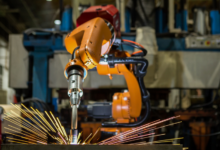Vacuum Force Guide: How to Measure Vacuum Suction

Knowing how to measure vacuum suction is essential for optimizing the performance of pneumatic lifting devices and other vacuum-based systems. Accurate measurement ensures that the right amount of force is applied to lift or hold objects securely without damaging them. In this guide, we’ll walk you through the principles of vacuum force, the tools used for measurement, and practical steps to achieve precise results helping you maximize efficiency, safety, and reliability in your industrial applications.
Understanding Vacuum Force
Vacuum force is the pulling power created when air is removed between a suction cup and the surface of an object. This pressure difference between the vacuum inside the cup and the surrounding atmosphere generates the holding or lifting force.
The strength of this force depends on several factors:
- Vacuum level: The deeper the vacuum (lower pressure), the stronger the suction.
- Suction cup area: Larger cups create more force due to greater surface contact.
- Object characteristics: Weight, surface texture, and orientation affect how securely it can be held.
Vacuum force is the pressure difference times the suction cup’s contact area, determining safe and reliable lifting.
Working Principle: How Vacuum Suction Works
Vacuum suction works by creating a pressure difference between the air inside a suction cup and the surrounding atmosphere. This pressure difference generates a holding force that keeps the object securely attached.
Step-by-Step Process:
- Contact & Seal: The suction cup touches the object, forming a tight, airtight seal.
- Air Evacuation: Air is removed from inside the cup using a vacuum pump, generator, or ejector.
- Pressure Difference Creation: Internal pressure drops below atmospheric pressure, and the higher outside pressure presses the cup onto the object.
- Holding Force Established: The object is securely held and can be lifted, rotated, or moved safely.
Supporting Forces:
- Gravity: Creates the atmospheric pressure needed for suction.
- Friction: Adds stability between the cup and the object, especially during vertical or sideways movement.
Vacuum suction safely grips and moves objects by harnessing the natural pressure difference between the vacuum inside the cup or the surrounding atmosphere.
Tools for Measuring Vacuum Suction
Accurately measuring vacuum suction is essential to keep your system running safely and efficiently. Here are the main tools used and what they do:
- Vacuum Gauges
Vacuum gauges are the most common way to check vacuum pressure. They come in analog (dial) or digital types and show pressure in units like mbar, kPa, or inHg.
- Analog gauges – Simple, durable, and easy to read, making them ideal for regular monitoring.
- Digital gauges – Provide precise readings, making them ideal when accuracy is important.
Best for: Basic setups and regular system checks.
- Vacuum Sensors / Transducers
These devices convert vacuum pressure into electrical signals that can be read by computers or control systems. This allows real-time monitoring and automation. They are commonly used in robotic arms, automated machines, and industrial equipment where maintaining consistent suction is critical.
Best for: Continuous, automated, or high-precision operations.
- Portable Vacuum Testers
These are compact, handheld devices that technicians use for quick vacuum measurements during inspections or maintenance. Many are battery-powered and connect directly to suction lines or pumps.
Best for: On-site diagnostics and fast troubleshooting.
- Data Logging Systems
Data loggers record vacuum pressure over time, giving insight into system performance. They help detect leaks, spot fluctuations, and plan preventive maintenance before problems occur.
Best for: Long-term monitoring, system optimization, and maintenance planning.
Choosing the right tool depends on how often and how precisely you need to measure vacuum pressure.
See also: Future of security screening: balancing tech innovations and privacy
Step-by-Step Procedure for Measuring Vacuum Suction
Step 1: Prepare the System
- Ensure the vacuum source (pump or ejector) is clean and functioning.
- Check hoses, fittings, and valves for leaks to ensure accurate readings.
Step 2: Connect a Vacuum Gauge or Sensor
- Attach the gauge with airtight fittings.
- Position it close to the suction cup for reliable measurements.
Step 3: Activate the Vacuum System
- Turn on the pump or ejector and let it reach a steady vacuum.
Step 4: Record Vacuum Levels
- Measure vacuum pressure with the cup empty (no load) and with the object (load) held.
Step 5: Verify Holding Force
- Calculate the holding force using vacuum level and the cup contact area.
- Ensure the force is sufficient for safe handling of the object based on its weight and surface type.
Holding Force Calculation: Key Factors
When determining the holding force required for a suction cup, several important factors must be considered:
- Workpiece Properties
The characteristics of the object being lifted directly affect suction performance:
- Material Type: Common materials include steel, glass, wood, plastic, etc. Different materials influence adhesion and seal quality.
- Surface Condition: Smooth surfaces provide a better seal, while rough, curved, porous, or oily surfaces reduce suction effectiveness and friction.
- Mass: The heavier the object, the greater the required holding force. Mass can be calculated as:
m=ρ×Vm = \rho \times Vm=ρ×V
where ρ\rhoρ is density and VVV is volume.
- Dynamic Factors
Movement and external forces influence the real-time load on the suction cup:
- Acceleration: Faster movements increase the required holding force.
- Gravity: Standard gravity is 9.81 m/s²; it contributes to the total force the suction cup must resist.
The combined effect of gravity and acceleration determines the dynamic force the suction cup experiences.
- Safety Factor
A safety factor ensures reliability and prevents slippage or accidents. Typical recommended values:
- Smooth surfaces: 2–3
- Rough or oily surfaces: 3–5
- Vertical lifts or porous materials: up to 6
- Friction Coefficient (μ)
Resistance between the suction cup and the surface. Lower μ requires a higher suction force. Typical values:
- Oily: 0.1
- Smooth plastic: 0.3
- Glass/Wood: 0.5
- Rough Wood/Concrete: 0.6–0.8
Considering all these factors helps ensure the suction cup can lift and hold objects safely in real-world conditions.
Best Practices for Accurate Measurement
- Choose the Right Suction Cup Shape for the Surface
Choose a cup that matches the surface you want to hold:
- Flat cups – Perfect for smooth, flat surfaces like glass or metal. They stick evenly and hold objects securely.
- Bellows cups – Have flexible folds that can adapt to uneven or slightly curved surfaces. Great for irregular shapes.
- Oval cups – Good for long or narrow objects. They spread suction along the length of the item.
- Select a Material for Your Conditions
The material affects grip, durability, and how well the cup works in different conditions:
- Temperature – Some materials handle heat better.
- Surface texture – Smooth vs. rough surfaces need different materials.
- Contaminants – Dirt, oil, or chemicals can make a suction cup grip weaker. Some materials are better at resisting these and keeping a strong hold.
Common materials:
- NBR (Nitrile Rubber) – Strong, oil-resistant, good for industrial use.
- Silicone – Flexible, heat-resistant, sometimes food-safe.
- EPDM – Resistant to heat, ozone, and chemicals, making it ideal for outdoor or harsh environments.
- Make Sure It Fits Your System
Check that the suction cup works with your equipment:
- Connection type – Does it fit hoses, robotic arms, or vacuum systems?
- Size and shape – Will it match the vacuum flow and grip properly?
- Load – Can it handle the object’s weight and movement safely?
- Get Expert Help for Tricky Situations
Some situations are more complicated and need advice:
- Porous materials – Wood, cardboard, or fabric may need special cups or settings.
- Fast movements – Rapid motion can cause slipping.
- Safety-critical items – Fragile or heavy objects must be handled carefully to avoid accidents.
Following these steps gives a stronger grip, longer-lasting equipment, and safer, more efficient operation.






